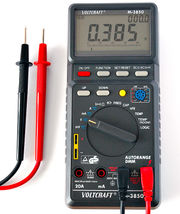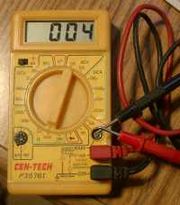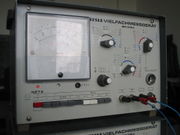Multimeter
howard piA digital multimeter
A low cost digital multimeter
|
A multimeter or a multitester is an electronic measuring instrument that combines several functions in one unit. The most basic instruments include an ammeter, voltmeter, and ohmmeter. Analog multimeters are sometimes referred to as "volt-ohm-meters", abbreviated VOM. Digital multimeters are usually referred to as "digital-multi-meters", abbreviated DMM. A multimeter can be a handheld device useful for basic fault finding and field service work or a bench instrument which can measure to seven or eight and a half digits of accuracy. Such an instrument will commonly be found in a calibration lab and can be used to characterise resistance and voltage standards or adjust and verify the performance of multi-function calibrators. Current, voltage, and resistance measurements are considered standard features for multimeter. AVO multimeters, a manufacturer of early multimeters, derived their name from amperes, volts, and ohms, the units used for the measurement of current, voltage, and resistance. Newer equipment can measure many other quantities. Some common additional measured quantities and the units in which they are measured:
A multimeter may be implemented with an analog meter deflected by an electromagnet, as a classic galvanometer; or with a digital display such as an LCD or Vacuum fluorescent display. Analog multimeters are not hard to find in the used market, but are not very accurate because of errors introduced in zeroing and reading the analog meter face.
|
Analog meters may be implemented with vacuum tubes to precondition and amplify the input signal. Such meters are known as vacuum tube volt meters (VTVM) or vacuum tube multimeters (VTMM).
The resolution of a multimeter is often specified in "digits" of resolution. The term "digits" dates back to the 1970's when multimeter vendors were very proud of how many digits their products could display (this was important, because readout displays were costly). The vendors started to specify the maximum resolution of the multimeter based on the digital display. For example, the term 5½ digits refers to the number of digits displayed on the readout of a multimeter. A 5½ digit multimeter would have five full digits that display values from 0 to 9 and one half digit that could only display 0 or 1. This digital multimeter could show positive or negative values from 0 to 199,999. For a modern DMM, such as a PC-based multimeter, the term "digits" actual maps to the noise performance of the device.
Modern multimeters are exclusively digital, and identified by the term DMM or digital multimeter. In such an instrument, the signal under test is converted to a digital voltage and an amplifier with an electronically controlled gain preconditions the signal. Since the digital display directly indicates a quantity as a number, there is no risk of parallax causing an error when viewing a reading.
Similarly, better circuitry and electronics have improved meter accuracy. Older analog meters might have basic accuracies of five to ten percent. Modern portable DMMs may have accuracies as good as ±0.025%, and bench-top instruments have accuracies in the single-digit parts per million figures.
The inclusion of solid state electronics, from a control circuit to small embedded computers, has provided a wealth of convenience features in modern digital meters. Commonly available measurement enhancements include:
- Current-limited tests for voltage drop across semiconductor junctions. This facilitates testing diodes and a variety of transistor types.
- A graphic representation of the quantity under test, as a bar graph. This makes go/no-go testing easy.
- A continuity tester that beeps when a circuit conducts.
- A low-bandwidth oscilloscope.
- A telephone test set.
- Automotive circuit testers, including tests for automotive timing and dwell signals.
- Simple data acquisition features to record maximum and minimum readings over a given period, or to take a number of samples at fixed intervals.
- Sample and hold, which will latch the most recent reading for examination after the instrument is removed from the circuit under test.
- Autoranging, which selects the correct range for the quantity under test without any risk of damaging the instrument.
Digital meters often feature circuitry or software to accurately measure AC voltages at any frequency. These meters integrate the input signal using the root mean square method, and will correctly read the true voltage of an input signal even if it isn't a perfect sine wave.
Modern meters may be interfaced with a personal computer by IrDA links, RS-232 connections, or an instrument bus such as IEEE-488. The interface allows the computer to record measurements as they are made or for the instrument to upload a series of results to the computer.
As modern appliances and systems become more complicated, the multimeter is becoming less common in the technician's toolkit. More complicated and specialized equipment replaces it. Where a service man might have used an ohmmeter to measure resistance while testing an antenna, a modern technician may use a hand-held analyzer to test several parameters in order to determine the integrity of a network cable.


